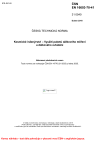Vánoční provoz a PF 2026
Vážení zákazníci,
aby bylo možné dodat objednané zboží před začátkem vánočních svátků, odešleme poslední várku zboží v tomto roce v pátek 19. prosince. Objednávky došlé po 10. hodině 19. prosince odešleme až 5. ledna 2026. Od 19. prosince do 2. ledna taktéž nebude možný osobní odběr objednaných norem.
Děkujeme za váš zájem v tomto roce,
přejeme vám hodně zdraví, pohody a úspěchů v roce 2026.
ČSN EN 16603-70-41 (310540)
Kosmické inženýrství - Využití paketů dálkového měření a dálkového ovládání
Anotace obsahu normy
This Standard addresses the utilization of telecommand packets and telemetry packets for the purposes of remote monitoring and control of spacecraft subsystems and payloads.
This Standard does not address missionspecific payload data packets, but the rules contained herein can be extended to suit the requirements of any mission.
This Standard does not address audio and video data as they are not contained within either telecommand or telemetry packets.
This Standard defines a set of services that satisfy all the fundamental operational requirements for spacecraft monitoring and control during spacecraft integration, testing and flight operations, refer to ECSS-E-ST-70-11. It also specifies the structure and contents of the telecommand packets used to transport the requests and the telemetry packets used to transport the reports.
This Standard can be used by any mission, no matter what its domain of application, orbit or ground station coverage characteristics. However, it is not the intention that the PUS should be applied in its entirety to a given mission. The services defined in this Standard cover a wide spectrum of operational scenarios and, for a given mission, only a subset of these services is likely to be appropriate.
Choices are made early in the design phase of a new mission resulting in the need to tailor the PUS to suit the requirements of that mission. These choices include:
o the on-board system design and architecture, in terms of the number of on-board application processes, their on-board implementation (e.g. the allocation to on-board processors) and their roles (i.e. which functions or subsystems or payloads they support);
o which PUS services are supported by each application process.
Each mission usually documents the results of this design and selection process in a "Space-to-Ground Interface Control Document".
Some missions implement a centralized architecture with a small number of application processes, whilst others have a highlydistributed architecture within which a correspondingly larger number of application processes are distributed across several on-board processors.
The specification of services in this Standard is adapted to the expectation that different missions require different levels of complexity and capability from a given service. To this end, all services are optional and a given service can be implemented at one of several distinct levels, corresponding to the inclusion of one or more capability sets. The minimum capability set corresponds to the simplest possible level that also remains sensible and coherent. At least this set is included in every implementation of a given service.
The standardized PUS services fulfil the following criteria:
o Commonality: each standard service corresponds to a group of capabilities applicable to many missions.
o Coherence: the capabilities provided by each standard service are closely related and their scope is unambiguously specified. Each standard service covers all the activities for managing interrelated state information and all activities that use that state information.
o Self-containment: each standard service has minimum and well-defined interactions with other services or on-board functions.
o Implementation independence: the standard services neither assume nor exclude a particular spacecraft architecture (hardware or software).
This Standard mainly addresses the requirements that apply to the spacecraft and its components. The ground segment counterpart requirements related to the testing or the operations of the spacecraft and its components can be derived from these requirements and are not specified in this Standard. Tailoring the PUS for a mission is mainly a task for the operations team and the spacecraft manufacturer. This Standard assumes that the mission ground segment used to test or operate the spacecraft implements all standardized capabilities and as such, does not further constrain the mission tailoring process of these capabilities.
The PUS should be viewed as a "Menu" from which the applicable services and servicelevels are selected for a given mission. This selection process is repeated for each on-board application process, since each application process is designed to provide a specific set of tailored services.
This standard may be tailored for the specific characteristics and constraints of a space project in conformance with ECSS-S-ST-00.
This Standard does not include any protection against inadequate operations. This is considered mission specific.
| Označení | ČSN EN 16603-70-41 (310540) |
|---|---|
| Katalogové číslo | 504060 |
| Cena | 4 050 Kč4050 |
| Datum schválení | 1. 4. 2018 |
| Datum účinnosti | 1. 5. 2018 |
| Jazyk | angličtina (obsahuje pouze anglický originál) |
| Počet stran | 644 stran formátu A4 |
| EAN kód | 8596135040605 |
| Tato norma nahradila | ČSN EN 14776 (310535) z ledna 2005 |
| Dostupnost | skladem (tisk na počkání) |
Další příbuzné normy
ČSN EN 16603-10-02 (310540)
Kosmické inženýrství - Ověřování
ČSN EN 16603-10-03 (310540)
Kosmické inženýrství - Zkoušení
ČSN EN 16603-10-04 (310540)
Kosmické inženýrství - Kosmické prostředí
ČSN EN 16603-10-06 (310540)
Kosmické inženýrství - Část 10-06: Specifikace technických požadavků
ČSN EN 16603-10-09 (310540)
Kosmické inženýrství - Referenční souřadnicový systém
ČSN EN 16603-10-11 (310540)
Kosmické inženýrství - Ergonomie
ČSN EN 16603-10-12 (310540)
Kosmické inženýrství - Metoda výpočtu dávek záření a jejich účinků a postup konstrukčních tolerancí
ČSN EN 16603-10-24 (310540)
Kosmické inženýrství - Management rozhraní
ČSN EN 16603-11 (310540)
Kosmické inženýrství - Definice úrovní technologické připravenosti (TRL) a jejich kritéria hodnocení
ČSN EN 16603-20 (310540)
Kosmické inženýrství - Elektrické a elektronické procesy


